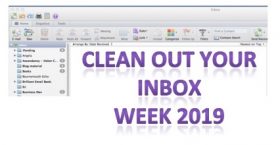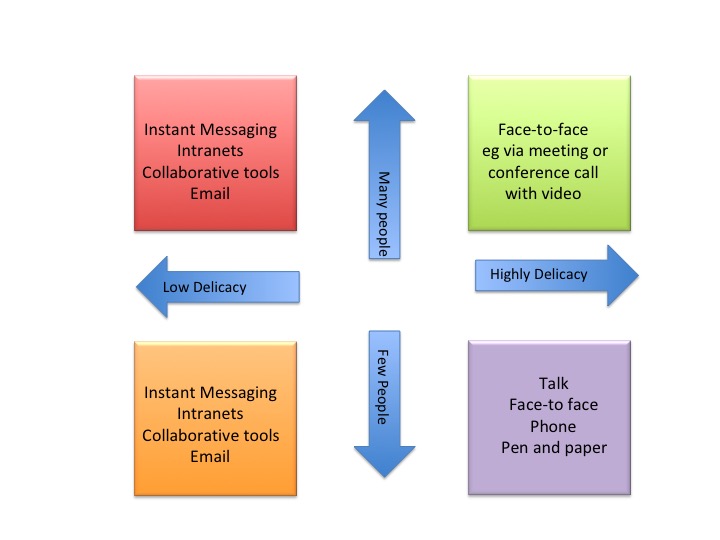Time is the scarcest resource and unless it is managed, nothing else can be managed. Peter Drucker

Clean Out Your Inbox Week 2019
Clean Out Your Inbox Inbox week 2019 is here. Why join in? Business email overload is still one executive’s main concerns according to recent surveys. They worry about cleaning out their inboxes and will stay up until 10.00pm clearing the backlog only to find their inbox full again in the morning. All this leads to increased stress and potential mental health problems. Sounds familiar? Join the club. This is why we have been running the International Clean Out Your Inbox Inbox week for over a decade to help you improve performance and creativity whilst reducing the stress and mental health issues arising from business email overload.
During Clean Out Your Inbox week we will share tips and hints on how to clean out your inbox, help other also clean out their inbox and then change people’s email behaviour to reduce business email overload long term.
It doesn’t matter what your role is in the organisation, PA, EA, CEO, Sales Director, etc., business email overload will be impacting you and your colleagues and can mean time wasted, an important email is overlooked, an email is sent in haste and causes the next email media disaster, an email is open quickly and initiates a cyber attack.
So lets get started aiming for a clean inbox by Friday.
Calibrate how clean is your inbox. Use our Cost of BusinessEmail Overload Calculator and dare to share the results as above.
Share your Clean Out Your Inbox week SMART goals and plans (see above). There are two a prizes for the best sets (copy of ‘Brilliant Email‘ and for PAs and EAs ‘Taking Control of Your Inbox‘).
Each day we will post the Clean Inbox week action for that day. Meanwhile ..
![]() Follow me on Twitter using #cleaninbox.
Follow me on Twitter using #cleaninbox.
![]() Join our Facebook page and Like us please.
Join our Facebook page and Like us please.
Tags: Brilliant Email, Business email overload, clean out your inbox week, cost of email overload, Mental Health and Email, Stress and email overload, Take Control of Your Inbox
Here are my top 10 tips (and resolutions) to reduce business email overload in 2019. These tips will enable you to take control of your inbox instead of allowing it to control your working day. This will enable you to improve your performance and well-being and reduce the risks of an email borne cyber attack through stupidity.
What are your New Year’s resolutions to reduce the level of business email overload in 2019?
Tags: 2019 email overload resolutions, Business Performance, Email born cyber crime, Google translate, Naked emails, Reduce business email overload
As IORG Social Media Chair, for the past four weeks my theme has been whether or not business email overload will still be a problem in 2019 and if so can we reduce it. Thinking outside the inbox will a key way to reduce business email overload in 2019. (A shorter version was published on the IORG website).
Thinking outside the inbox is neither easy nor intuitive, There are now multiple excellent other ways to communicate electronically from instant messaging via Skype for Business or What’s App to sophisticated collaborative tools like Slack or SharePoint. Sadly, what often happens is that organisations adopt alternatives to email with no clear guidelines on what to use when. With no clear conventions and frameworks all that happens is that email overload turns into a severe attack of information overload because now you have at least three if not four or five different channels to check.
In the absence of organisational guidelines, here is a simple framework which others with whom I have worked have found very useful. Its called the PNPD Framework for Thinking Outside the Inbox
For any form of communication, there are basically four factors to consider when deciding which medium to use.

Here are two examples of how to apply the PNPD framwork to think outside the inbox to reduce email and information overload.
Scenario 1 – Conversation
Private between two people, delicate but a permanent record of the final discussion will be needed (eg performance appraisal, salary negotiation, disciplinary meeting).
Best option – conversation (face-to-face if possible otherwise virtual) followed up by an email confirming the discussion.
Privacy is high: Numbers are low: Permanency is high: Delicacy is high.
Scenario 2 – Instant messaging
A public message for several people if not the whole office which if not seen here and now is of no relevance later. It does not matter how people react. For example, testing the fire alarm, cakes for your birthday.
Best option – Instant messaging.
Privacy is low: Numbers are high: Permanency is low: Delicacy is low.
For more information on the PNPD Thinking Outside the Inbox Framework see Taking Control of Your Inbox.
It is my view that email is here to stay and the real challenge is how to manage our use of it better. Clearly one way is to manage the actual flow of email traffic in and out of your inbox more efficiently. In relation to the former this means being brave and thinking outside the inbox and consciously choosing to use an alternative.
What is your view?
Tags: IORG, Reduce business email overload, Taking Control of Your Inbox, Thinking Outside the Inbox
 A constant problem associated with business email overload and hence information overload is picking out the important emails from all the dross. Deleting the less important ones often results in deleting those you really wanted, especially when using a mobile device. They key is to remember it is your inbox and no one (at least no email) should arrive without your permission.
A constant problem associated with business email overload and hence information overload is picking out the important emails from all the dross. Deleting the less important ones often results in deleting those you really wanted, especially when using a mobile device. They key is to remember it is your inbox and no one (at least no email) should arrive without your permission.
See the path to your inbox as an information highway along which emails travel but you and you alone decide which travel in the fast lane and arrive directly in your inbox and which travel in the slow lane via a width restrictor (folder).
Over the next week if you truly want to reduce your business email overload intake, do an inbox audit to benchmark your email intake using this simple five step exercise.
You must be absolutely ruthless otherwise at the end of the week you will still be suffering with business email and information overload and your inbox will remain heavily congested.
This blog is part of the series being written for IORG on whether or not business email overload will still be a problem in 2019.
Tags: Business email overload, Inbox audit, Reduce business email overload
Suffering from chronic business email overload? Like many business executives, you probably receive about 50 to 70 emails a day which is one new email every six to nine minutes. What if you could reduce that to a more manageable number eg 40 to 50 and use the time for other more productive tasks? That is a common question posed in Smart Email Management workshops. Is it even possible?
The answer is yes. But to do so you must first identify who is causing the email overload. Heaven forbid, could it even be you through your leadership style and email behaviour?

Three quick and easy steps to enable you to identify the business email overload culprits.
Now you are in a position to reduce your business email overload. Five possible quick ways are outlined below. Which ones you choose depends on the outcomes from the review above..
Five ways to move forward and reduce business email overload immediately
Thus the key culprits causing email overload may not be solely the other senders. In part it might just be you, through your management style and over reliance on email. This is the part which is harder to change.
Do you want to create more time in the day by reducing email overload through techniques like these? Contact us now to discuss how our Smart Email Management workshops, coaching and webinars can help you and your colleagues.